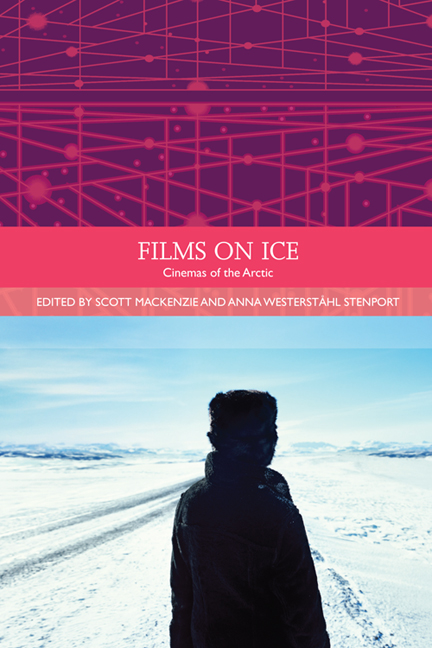Book contents
- Frontmatter
- Contents
- List of Illustrations
- Acknowledgements
- Traditions in World Cinema
- Introduction: What are Arctic Cinemas?
- PART I GLOBAL INDIGENEITY
- PART II HOLLYWOOD HEGEMONY
- 8 Fact and Fiction in ‘Northerns’ and Early ‘Arctic Films’
- 9 California's Yukon as Comic Space
- 10 ‘See the Crashing Masses of White Death…’: Greenland, Germany and the Sublime in the ‘Bergfilm’ SOS Eisberg
- 11 The Threat of the Thaw: The Cold War on the Screen
- 12 Hollywood Does Iceland: Authenticity, Genericity and the Picturesque
- 13 White on White: Twenty-First-Century Norwegian Horror Films Negotiate Masculinist Arctic Imaginaries
- PART III ETHNOGRAPHY AND THE DOCUMENTARY DILEMMA
- PART IV MYTHS AND MODES OF EXPLORATION
- Notes on the Contributors
- Index
10 - ‘See the Crashing Masses of White Death…’: Greenland, Germany and the Sublime in the ‘Bergfilm’ SOS Eisberg
from PART II - HOLLYWOOD HEGEMONY
Published online by Cambridge University Press: 05 September 2016
- Frontmatter
- Contents
- List of Illustrations
- Acknowledgements
- Traditions in World Cinema
- Introduction: What are Arctic Cinemas?
- PART I GLOBAL INDIGENEITY
- PART II HOLLYWOOD HEGEMONY
- 8 Fact and Fiction in ‘Northerns’ and Early ‘Arctic Films’
- 9 California's Yukon as Comic Space
- 10 ‘See the Crashing Masses of White Death…’: Greenland, Germany and the Sublime in the ‘Bergfilm’ SOS Eisberg
- 11 The Threat of the Thaw: The Cold War on the Screen
- 12 Hollywood Does Iceland: Authenticity, Genericity and the Picturesque
- 13 White on White: Twenty-First-Century Norwegian Horror Films Negotiate Masculinist Arctic Imaginaries
- PART III ETHNOGRAPHY AND THE DOCUMENTARY DILEMMA
- PART IV MYTHS AND MODES OF EXPLORATION
- Notes on the Contributors
- Index
Summary
Why transfer a film to an iceberg when every ascent of an iceberg is more dangerous than any conquest of the most difficult Alpine peaks?’ (Fanck 1933: 9; trans. by the author)
A FILM EXPEDITION TO GREENLAND AND THE THIRD REICH
Arnold Fanck (1889–1974), director of SOS Eisberg, raises this question at the beginning of his book about the so-called ‘Greenland expedition of the Universal film SOS Eisberg’, which was published in 1933, the year of the film's release. This is just one of a number of publications about the shooting of the film, which took place in Western Greenland in 1932 (for other accounts, see Riefenstahl 1933; Sorge 1933; and Udet 1935). The shoot is often referred to as a ‘film expedition’ and, consistent with this view, the cast are described as ‘expedition participants’ in Fanck's book (Fanck 1933: 5f). This analogy between the shooting of a film and a polar expedition is one remarkable feature of this – in Fanck's words – ‘first major film about Greenland that it was possible to shoot in this unexpectedly beautiful country’ (Fanck 1933: 7). The set-up of the undertaking mimics the Arctic expeditions and their filmic representations, which were familiar to the public at beginning of the twentieth century. SOS Eisberg could even be read as a feature film adaptation of the silent scientific documentary Die deutsche Expedition vom Jahre 1929 auf dem grönländischen Inlandeis, a film set in the context of a scientific expedi tion to Greenland led by meteorologist and polar scientist Alfred Wegener (1880–1930), who died on a subsequent expedition to Greenland in 1930 (cf. Muller 2011b: 309–30). A scientist himself, Fanck was deeply interested in intersections between science and aesthetics in film, and used explicit references to the Wegener expeditions that would have been immediately understood by the contemporary German cinema audience. These references can be found both in the choice of cinematic devices, such as the use of cartography to show the expedition's geographic destination in Greenland, and on the narrative level.
- Type
- Chapter
- Information
- Films on IceCinemas of the Arctic, pp. 148 - 160Publisher: Edinburgh University PressPrint publication year: 2014



